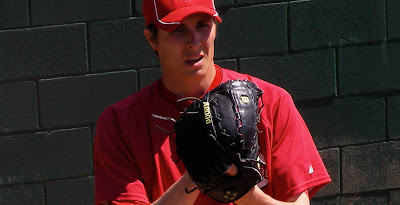 David "Homer" Bailey, from La Grange, Texas, is the single most important pitcher in the Reds organization for the 2010 season. But you wouldn't have been able to tell that based on what's being reported on the information superhighway.
David "Homer" Bailey, from La Grange, Texas, is the single most important pitcher in the Reds organization for the 2010 season. But you wouldn't have been able to tell that based on what's being reported on the information superhighway.Aroldis Chapman has a mania. Reds' rookie pitcher Mike Leake has a mini-mania.
Not Homer Bailey. A local article here (Homer's all grown up), a national article there (Homer's glad the spotlight is elsewhere). But virtually nothing about his baseball talent and prospects on the mound.
 Don't be fooled by the 23-year-old's mania-free zone, though. No other pitcher on the Reds staff is more likely to see their personal success track as close with the team's trajectory this year than Bailey.
Don't be fooled by the 23-year-old's mania-free zone, though. No other pitcher on the Reds staff is more likely to see their personal success track as close with the team's trajectory this year than Bailey.We pretty much know what to expect from veterans Bronson Arroyo, Aaron Harang. Absent a huge breakthrough in consistency, Johnny Cueto seems likely to duplicate his roughly-.500 record. The other Reds' starting pitcher candidates are very young. Sure, there's a chance that the shooting star of Aroldis Chapman will streak across major league baseball's sky this year, but even with flashes of brilliance, realistically his impact in 2010 is likely to be limited, even if the media frenzy so predictably won't be.
 Homer Bailey will be the pivotal difference-maker for the Reds this year.
Homer Bailey will be the pivotal difference-maker for the Reds this year.High school superstar
Homer Bailey was the Reds' first round draft choice in June of 2004. He had just completed a much-heralded high school career, culminating in being named the High School Player of the Year by USA Today. Those accolades were not unwarranted. Homer's high school resumé was replete with accomplishments such as 536 strikeouts in 298 innings, two Texas state championships etc.

A tantalizing glimpse in 2009
After several years of hype followed by disappointment, last fall the Reds got a month-long installment of that Homer Bailey. In his last nine starts of 2009, he recorded a 1.70 ERA and a 6-1 record, while being victimized by two blown saves. His ERA over that period of time was the best in the entire major leagues. I'll say that again: over the last six weeks of 2009, the starting pitcher in the entire MLB with the lowest ERA was the Reds' Homer Bailey.
 What happened? From whatever combination of factors, his pitching took an enormous step forward. Homer's fastball velocity consistently registered in the mid-to-high 90s for the first time in his professional career. He developed a split-finger pitch to accompany his fastball and breaking balls. Maybe it was just the added maturity that comes from experience and a dose of humility.
What happened? From whatever combination of factors, his pitching took an enormous step forward. Homer's fastball velocity consistently registered in the mid-to-high 90s for the first time in his professional career. He developed a split-finger pitch to accompany his fastball and breaking balls. Maybe it was just the added maturity that comes from experience and a dose of humility.Today's Performance
Homer took the mound this hot afternoon at Goodyear Ballpark against the Cleveland Indians. He pitched reasonably well, allowing a couple of runs over 3.2 innings. Homer flashed moments of brilliance, such as when he struck out former Reds outfielder Austin Kearns with a wicked breaking ball to end the third inning with bases loaded. On the other hand, he pitched with runners on base all four innings, primarily because he wasn't getting his first pitch over for a strike.


Here Homer is warming up before the game, with new Reds pitching coach, Bryan Price, watching intently.

Homer's ready
The conclusion to 2009 left many encouraging signs for Homer's upcoming year. The potential for dominance is clearly there. His high school career is evidence of that. If Homer puts it all together, he'll become a 15-game (or more) winner with an ERA below 3.50. If that happens, the Reds have a great chance not only of finishing above .500 for the first time in nearly a decade, but also to make the post-season -- this year.
 Does that put a lot on Homer's broad Texas shoulders? Sure does. But as Homer has recently said himself: "No excuses any more. It's time."
Does that put a lot on Homer's broad Texas shoulders? Sure does. But as Homer has recently said himself: "No excuses any more. It's time."



No comments:
Post a Comment